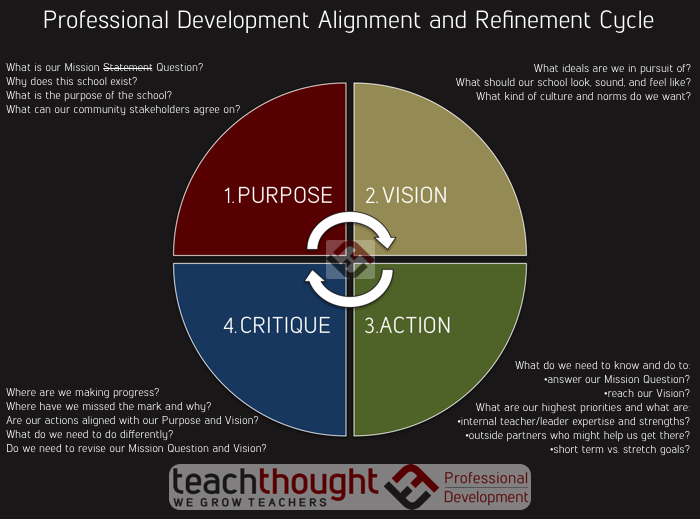
How Can You Avoid Pointless Professional Development?
contributed by Drew Perkins
We’ve all been there.
Professional Development that felt pointless and left us wondering why we were there. It might have been because the person(s) facilitating the learning was not very good or the topic was actually just something that could have been included in an email and that is truly frustrating. But what about those instances where the topic or the person is actually good but you just don’t feel like you need to be there? Misaligned PD can lead to wasted hours, burned-out teachers, and a lack of progress towards the goal of improving the quality of the teaching and learning.
Purpose
Just as it’s important to be clear in your classroom around purpose, it’s also vital to the long-term growth of a school and/or district. With that in mind I like to suggest schools take a different approach to develop their Mission/Purpose by turning their Mission Statement into a Mission Question. So instead of something like:
“We will prepare our students in and out of the classroom to thrive in a complex, changing world.”
It becomes:
“How can we prepare our students in and out of the classroom to thrive in a complex, changing world?”
With this simple step, we’re instantly pushed to engage in the process of inquiry and critical thinking as we parse out the pieces of the question for value and next steps. Often this results in a deeper analysis of the usual generic set of platitudes we see in Mission Statements and can lead to a more focused and pragmatic version.
Vision
Like Mission Statements, these tend to find their way to fill filing cabinets and perhaps somewhere on the school website to be glossed over by eyes looking for useful content. To flesh this out it can be helpful to once again engage in inquiry by asking, “what are the characteristics, traits, and attributes of our ideal school?” Taking steps to gather input from community stakeholders from the superintendent to students and teachers as well as community members and parents and everyone in between can build consensus and a more accurate vision. Now we have something to aim for.
Action
With our Purpose and Vision clearly in place, we can get to work building the Action pieces of professional development. What must we know and do to attain our vision and complete our purpose? This process applies to the big picture district leaders as they balance outside Professional Development partners (who should also ask for and work to align to Purpose and Vision) with internal expertise in the teaching and coaching ranks.
Ideally, it also applies to individuals as they align their personal purpose and vision (growth plans) with the district and/or school versions and plan out how to reach those goals. Wouldn’t it be nice if these pieces could be the basis for collaborative dialogue amongst peers to refine one’s own work instead of the typical “evaluation” process? An important side note here is to prioritize those things that should and can, because of resources, come first. Focusing on those things while simultaneously planning for those longer-term ‘stretch’ goals can prevent the sense of flailing about that we sometimes see (and feel) with district PD.
Critique
The last step here is perhaps a bit misleading as Critique really is an ongoing process and not best left to last. We want a culture of constant reflection throughout this cycle to formatively assess how well things are progressing. Are our professional development Actions all pointing toward our Purpose and Vision? How well are they accomplishing those things? What might we need to do differently or better? Are our Purpose and Vision still what we’re after or do we need to revise? Again, this process can and should be done collaboratively where the appropriate stakeholders have the opportunity for voice and autonomy.
Research shows autonomy, mastery and purpose are powerful motivators. We also know that teachers are passionate about improving their craft but often feel professional development is way short in that pursuit. Engaging in a thoughtful cycle of alignment can yield powerful growth for districts and schools AND reward teachers by meaningfully including them in that dialogue and empowering them to make PD work for them instead of a pointless endeavor.
Image attribution Tom Brunemyer
